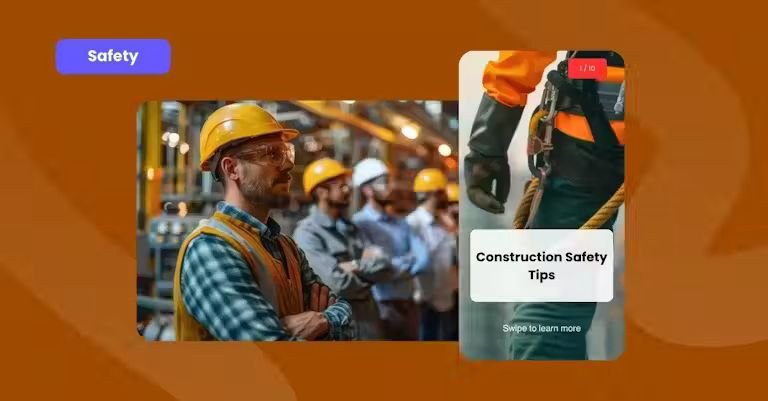10 Critical Safety Tips for Construction Work
Construction work is inherently dangerous. From towering scaffolds to heavy machinery, every task carries some level of risk. The construction industry accounts for a major portion of workplace injuries and fatalities each year. In fact, falls, electrocutions and equipment-related accidents make up a large percentage of reported incidents.
By following safety protocols, workers and employers can create an environment where risks are minimised. This article lays out 10 critical safety tips for construction workers to adopt. Each tip is practical, effective and proven to save lives.
10 Critical Safety Tips for Construction Work

1.Wear Proper Safety Gear
Personal protective equipment (PPE) shields workers from the dangers around them. A hard hat can protect against falling debris, safety glasses shield eyes from dust and sparks and gloves safeguard hands from sharp objects or hazardous materials.
The type of gear required depends on the job. Welders need protective masks, while workers in noisy environments need ear protection. Reflective vests are critical in low-visibility conditions.
Employers should ensure PPE is available and properly maintained, while workers must make it a habit to wear their gear consistently. A helmet left in a locker doesn’t do much good when something falls.
2.Ensure Regular Training
The construction industry evolves rapidly, introducing new tools, materials and methods. Without updated knowledge, even seasoned workers can make mistakes. Training sessions should cover everything from equipment handling to emergency procedures.
Topics like fall prevention, ladder safety, and fire protocols are just the start. Hands-on training is efficient for teaching workers how to operate machinery safely. Refresher courses and workshops should be a regular part of a worker’s schedule. A well-trained team is a safer, more efficient team.
3.Conduct Daily Safety Briefings
Construction is full of hazards, which is why it’s important to start each shift with a safety briefing. These quick meetings allow workers to discuss the day’s goals, highlight specific hazards and remind them of safety protocols.
For example, if heavy machinery is used in a particular area, workers should be aware of blind spots or restricted zones. Weather conditions that pose additional risks—like slippery surfaces during rain—should be addressed during the briefing.
Clear communication is the backbone of these discussions. Supervisors should encourage questions and feedback to ensure everyone understands the day’s safety expectations.
Read also: Accurate Costing in Complex Construction Projects
4.Maintain Clean and Organised Work Areas
A tidy and organised workspace is essential for maintaining safety and efficiency. In busy environments like construction sites, disorganised tools and debris can lead to accidents, including trips, falls, and collisions. Keeping the area clean throughout the day minimises risks and creates a safer environment for everyone.
Maintaining order involves more than end-of-day clean-ups. It means returning tools to their designated places after use, ensuring walkways are clear, and disposing of waste materials promptly and correctly. Proper management of hazardous substances is also critical to maintaining a safe workspace.
Completing an online COSHH course provides valuable insights for workers dealing with dangerous substances like chemicals or flammable materials. Such training programmes can help workers understand their legal responsibilities Control of Substances Hazardous to Health COSHH Regulations 2002. They enable teams to understand risks associated with hazardous substances and the importance of safe storage, handling, and disposal.
A clean and organised work area reduces hazards and creates a professional and efficient environment, benefiting both employees and employers alike.
5.Managing Asbestos Risks on Construction Sites
Exposure to asbestos in construction settings is a significant concern, especially during renovation, maintenance, or demolition activities. Before its ban in 1999, asbestos was widely used in the UK in building materials like insulation, ceiling tiles, roofing, and pipe lagging. Many older structures still contain asbestos, making its disturbance during work a major health risk.
When asbestos-containing materials are damaged or disturbed, tiny fibres are released into the air. These fibres are invisible to the naked eye and, when inhaled, can cause serious health conditions like asbestosis, lung cancer, and mesothelioma. Workers such as builders, electricians, and plumbers are particularly at risk during activities like drilling, cutting, or sanding, which can unknowingly disturb asbestos.
To address these risks, employers and building managers must properly identify and manage asbestos-containing materials. Completing duty to manage asbestos can help construction teams identify asbestos, assess its condition and implement control measures.
6.Monitor and Limit Exposure to Hazardous Materials
Construction sites are often home to dangerous substances, from asbestos to silica dust to industrial chemicals. Without proper precautions, exposure to these materials can lead to long-term health problems. Workers should be aware of the materials they handle and the risks involved. Labels, warning signs, and safety data sheets are critical resources. Protective gear, such as masks, gloves and respirators, can reduce exposure. Proper ventilation systems and air filters also help keep harmful particles out of the air. Lastly, hazardous materials should be stored and disposed of according to strict guidelines.
7.Encourage Open Communication About Hazards
Workers need to feel comfortable speaking up about hazards or near misses. A problem spotted early can often be fixed before it leads to an accident. Creating a workplace culture of open communication starts with management. Supervisors should actively encourage workers to report concerns, whether it’s a loose railing or a malfunctioning tool. Addressing safety concerns quickly shows workers that their input matters and reinforces the importance of a safe work environment.
8.Use Ergonomic Tools and Practices
Construction work is physically demanding. Repetitive motions, awkward postures and heavy lifting can damage the body. Ergonomic tools and practices can help reduce this strain. For instance, tools with padded grips or adjustable handles can make tasks less tiring and ease joint pain for workers who spend hours on their feet. Proper lifting techniques must also be taught to workers. Simple changes, such as bending the knees and keeping loads close to the body, can prevent serious injuries.
9.Adhere to Load Handling Guidelines
Heavy loads are part of the job, but mishandling them can lead to serious injuries. Strained muscles, back injuries and hernias are common in construction work.
To prevent these injuries, workers should follow established load-handling guidelines. When manual lifting is necessary, workers should:
- Evaluate the weight of the load prior to lifting. Evaluate the weight of the load prior to lifting.
- Lift with their legs, not their back.
- Avoid twisting or jerking motions.
- Supervisors should also ensure that workers aren’t overburdened. Sharing the load or taking multiple trips is always better than risking an injury.
10.Ensure Emergency Procedures Are Well Understood
Emergencies can happen at any time, including structural collapses and medical emergencies. Without a clear plan, chaos can make a bad situation even worse. Every construction site should have detailed emergency procedures. Workers need to know where to find exits, fire extinguishers and first aid kits. During safety briefings, emergency contacts and assembly points should be clearly communicated. Practising the response to different scenarios ensures that workers know exactly what to do when seconds count. Preparation saves lives.
Conclusion
Every worker has a role to play in creating a safer environment. Continuous learning, vigilance and open communication are key to reducing risks. By prioritising safety, workers and employers can build more than just structures—they can build a culture of care and responsibility.



